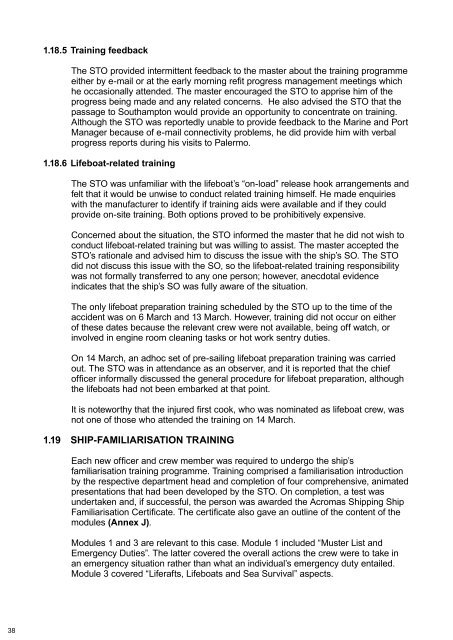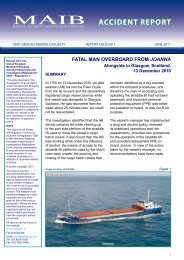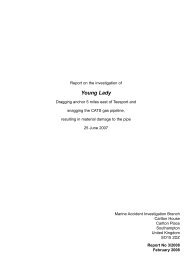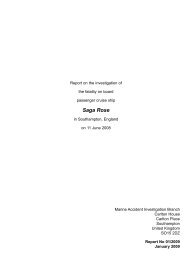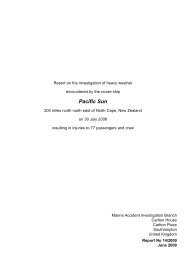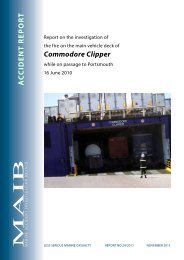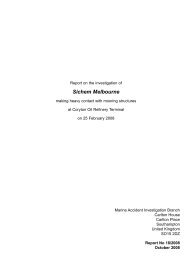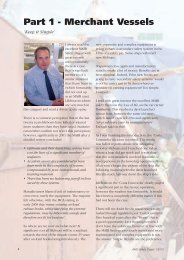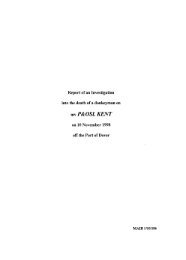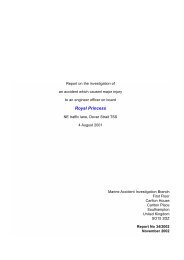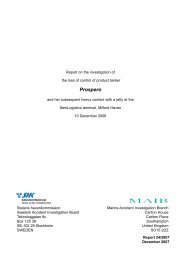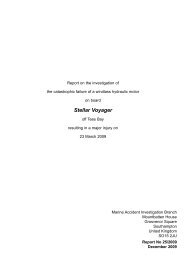SECTION 4 - Marine Accident Investigation Branch
SECTION 4 - Marine Accident Investigation Branch
SECTION 4 - Marine Accident Investigation Branch
You also want an ePaper? Increase the reach of your titles
YUMPU automatically turns print PDFs into web optimized ePapers that Google loves.
38<br />
1.18.5 Training feedback<br />
The STO provided intermittent feedback to the master about the training programme<br />
either by e-mail or at the early morning refit progress management meetings which<br />
he occasionally attended. The master encouraged the STO to apprise him of the<br />
progress being made and any related concerns. He also advised the STO that the<br />
passage to Southampton would provide an opportunity to concentrate on training.<br />
Although the STO was reportedly unable to provide feedback to the <strong>Marine</strong> and Port<br />
Manager because of e-mail connectivity problems, he did provide him with verbal<br />
progress reports during his visits to Palermo.<br />
1.18.6 Lifeboat-related training<br />
The STO was unfamiliar with the lifeboat’s “on-load” release hook arrangements and<br />
felt that it would be unwise to conduct related training himself. He made enquiries<br />
with the manufacturer to identify if training aids were available and if they could<br />
provide on-site training. Both options proved to be prohibitively expensive.<br />
Concerned about the situation, the STO informed the master that he did not wish to<br />
conduct lifeboat-related training but was willing to assist. The master accepted the<br />
STO’s rationale and advised him to discuss the issue with the ship’s SO. The STO<br />
did not discuss this issue with the SO, so the lifeboat-related training responsibility<br />
was not formally transferred to any one person; however, anecdotal evidence<br />
indicates that the ship’s SO was fully aware of the situation.<br />
The only lifeboat preparation training scheduled by the STO up to the time of the<br />
accident was on 6 March and 13 March. However, training did not occur on either<br />
of these dates because the relevant crew were not available, being off watch, or<br />
involved in engine room cleaning tasks or hot work sentry duties.<br />
On 14 March, an adhoc set of pre-sailing lifeboat preparation training was carried<br />
out. The STO was in attendance as an observer, and it is reported that the chief<br />
officer informally discussed the general procedure for lifeboat preparation, although<br />
the lifeboats had not been embarked at that point.<br />
It is noteworthy that the injured first cook, who was nominated as lifeboat crew, was<br />
not one of those who attended the training on 14 March.<br />
1.19 SHIP-FAMILIARISATION TRAINING<br />
Each new officer and crew member was required to undergo the ship’s<br />
familiarisation training programme. Training comprised a familiarisation introduction<br />
by the respective department head and completion of four comprehensive, animated<br />
presentations that had been developed by the STO. On completion, a test was<br />
undertaken and, if successful, the person was awarded the Acromas Shipping Ship<br />
Familiarisation Certificate. The certificate also gave an outline of the content of the<br />
modules (Annex J).<br />
Modules 1 and 3 are relevant to this case. Module 1 included “Muster List and<br />
Emergency Duties”. The latter covered the overall actions the crew were to take in<br />
an emergency situation rather than what an individual’s emergency duty entailed.<br />
Module 3 covered “Liferafts, Lifeboats and Sea Survival” aspects.


